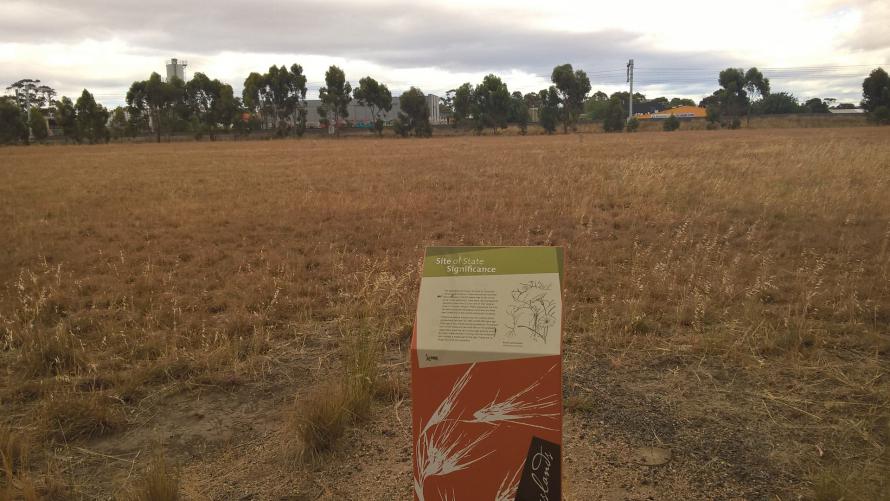
This small, species rich grassland in the middle of Sunbury is highly significant and provides tremendous education potential. The site is open with a slight fall from north to south. The grassland is dominated by Themeda triandra (Kangaroo Grass) with most native species occuring at low frequencies across the reserve. Native grassland with different species composition occurs on the knoll and in a scape created when the adjoining railway line was built.
Between the Melbourne-Bendigo Railway and Evans Street in the town of Sunbury, 30 km northwest of Melbourne
There is an access track with interpretive signage boards along the east and south sides of the reserve
Natural Heritage Officer, Hume City Council Ph 9205 2200.
Friends of Evans Street Wildflower Grassland helps maintain the environmental quality of the grassland
Address: PO Box 604, Sunbury 3429
This grassland was "discovered" in 1983 by Friends of Organ Pipes National Park when they were looking for seed sources for grassland restoration. It had survived because it has been set aside for future use by the Victorian railways and had been burned regularly as a fire proptection measure. The land was then owned by the Victorian government who sold it to the Shire of Bulla who wanted to build a car park for the nearby Sunbury town centre. The Friends of Evans Street and the Victorian National Parks Association fought a protracted conservation battle to preserve the grassland which included a 10 year conservation covenant being placed on the site in 1993 before a permanant Trust for Nature conservation covenenat was applied in 2004. However as part of this agreement the majority of the most northern land parcel, which had lower biodiveristy values, was allowed to be developed.
In 1983 the site was described by the late Dr Jim Willis, Government Botanist, as "the best example I have ever seen of an original grassland flora typical of the Keilor baslat plains. It is remarkable that this community of native plants has survived to the preset nday in such a vigorous and relatively pure condition.... This is an astonishing wildflower area, if not quite unique in Victoria...." Evans Street remains as one of the best native grasslands in the Melbourne region with a number of state and federally listed plant species. It is also a site for threatened species reintroductions.
The stony knoll near the middle of the reserve formed when molten basalt lava flows from nearby volcanoes almost covered and fired the previous sedimentary rock into a lens of Ordovician silcrete. The knoll supports hedge wattle and a grassland with different species composition to the rest of the reserve including Brunonia australis, Pelargonium rodneyanum, Arthropodium strictum and Stylidium graminifolium.
Regular ecological burning to maintain biodiversity values, ongoing weed control particularly for priority species such as Nasella sp., Briza sp, Phalaris aquatica, Plantago lanceolata, Trifolium sp., reintroduction of rare flora species.
No dogs
Acaena echinata, Aira caryophyllea, Arthropodium strictum, Asperula conferta, Austrostipa scabra, Austrostipa semibarbata, Austrostipa spp., Avena barbata, Bossiaea prostrata, Briza maxima, Briza minor, Brunonia australis, Caesia calliantha, Calocephalus citreus, Carex breviculmis, Centaurium tenuiflorum, Chrysocephalum apiculatum, Cirsium vulgare, Convolvulus angustissimus, Conyza sumatrensis, Cyperus eragrostis, Dianella admixta, Dianella sp. aff. longifolia, Dichelachne crinita, Dillwynia cinerascens, Epilobium hirtigerum, Eryngium ovinum, Geranium retrorsum, Haloragis heterophylla, Hypericum perforatum, Juncus amabilis, Juncus spp., Lachnagrostis aemula, Lactuca serriola, Lamarckia aurea, Leptorhynchos tenuifolius, Lomandra nana, Maireana decalvans, Microtis spp., Oxalis perennans, Pelargonium rodneyanum, Phalaris aquatica, Pimelea curviflora, Plantago gaudichaudii, Plantago lanceolata, Poa sieberiana, Romulea rosea, Rumex dumosus, Rytidosperma caespitosum, Rytidosperma duttonianum, Schoenus apogon, Sebaea ovata, Senecio hispidulus, Senecio quadridentatus, Sonchus oleraceus, Thelymitra spp., Themeda triandra, Tricoryne elatior, Trifolium angustifolium, Trifolium campestre, Velleia paradoxa, Veronica gracilis, Vicia sativa, Vittadinia gracilis, Vulpia bromoides, Wahlenbergia communis, Walwhalleya proluta
Common Ringtail Possum, House Mouse, European Rabbit, Red Fox, Grass Skink, Australian Magpie, Australian Raven, Australian White Ibis, Black-shouldered Kite, Brown Songlark, Brown Thornbill, Common Blackbird, Common Myna, Common Starling, European Goldfinch, European Greenfinch, Grey Fantail, Horsfield's Bushlark, House Sparrow, Little Raven, Long-billed Corella, Magpie-lark, Masked Lapwing, Pacific Black Duck, Rainbow Lorikeet, Red Wattlebird, Red-rumped Parrot, Rock Dove, Silvereye, Spotted Turtle-Dove, Stubble Quail, Sulphur-crested Cockatoo, Superb Fairy-wren, Welcome Swallow, White-plumed Honeyeater, Willie Wagtail, Yellow-plumed Honeyeater, Yellow-rumped Thornbill
- Morgan, J. W. 1998. Patterns of invasion of an urban remnant of a species-rich grassland in southeastern Australia by non-native plant species. Journal of Vegetation Science 9:181-190.
- Morgan, J. W., and T. S. Rollason. 1995. Base-line monitoring of a significant grassland remnant at Evans Street, Sunbury, Victoria. The Victorian Naturalist 112:148-159.
- https://www.environment.gov.au/system/files/resources/fd1d7659-b615-43ae...